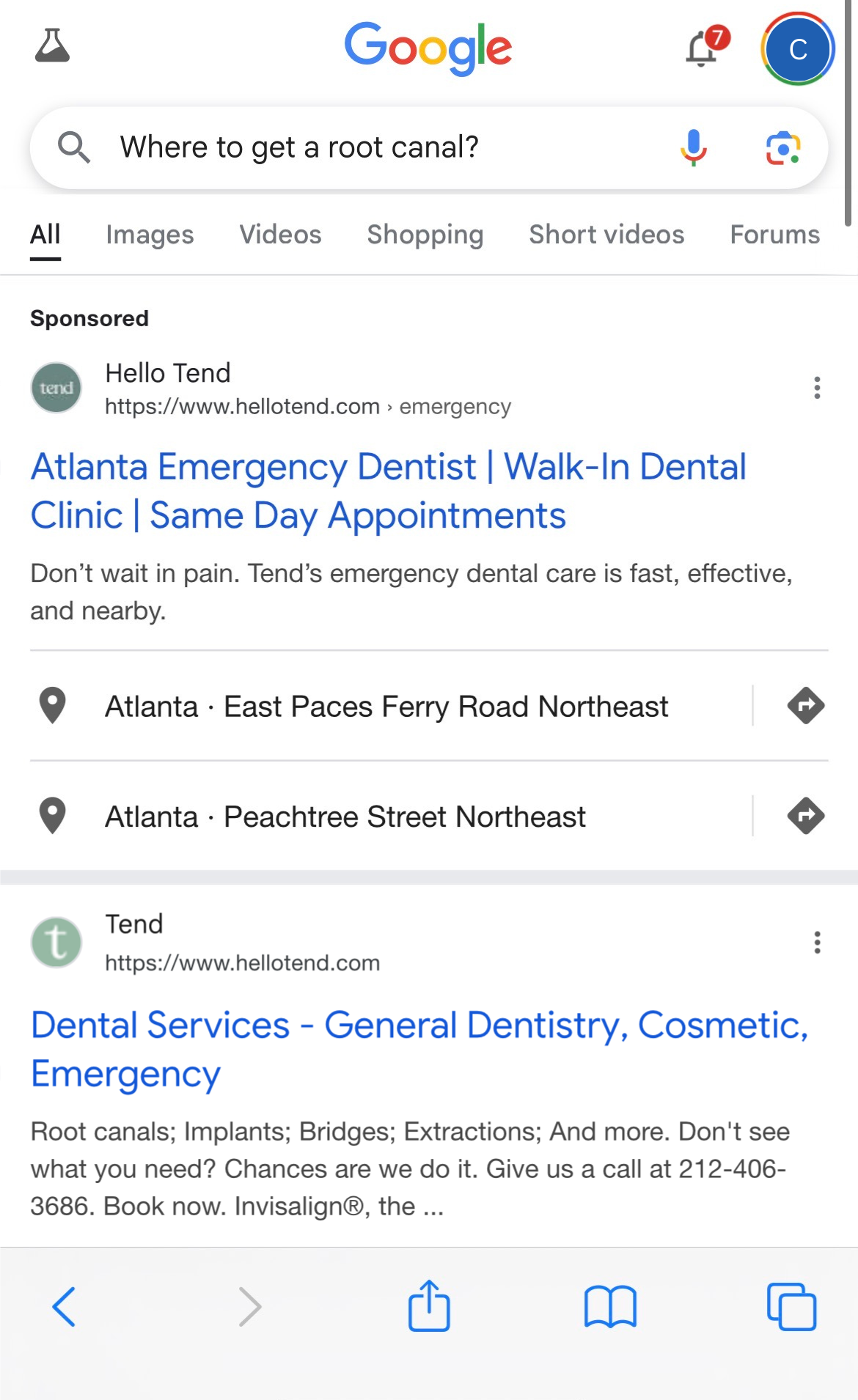For healthcare marketers, identifying and using the right keywords to target the right people is vital to succeed in a highly competitive industry. However, there are various potential issues to be aware of, including obstacles that could stand between you and generating valuable new leads. And one of these is keyword cannibalization.
Table of Contents
What does that mean? And how can you avoid it? We’ll address both questions below.
What is Keyword Cannibalization?
At first glance, “cannibalization” may seem like a somewhat grizzly term for anything related to digital marketing, but it’s certainly an effective way to draw attention to an important issue that could have a significantly negative impact on campaign performance.
In a paid search and organic SEO search environment, keyword cannibalization refers to a particularly frustrating situation: as your organic SEO and paid search strategies overlap, they begin competing with one another for clicks and conversions.
This can lead to two outcomes, both detrimental to campaign success:
- A decrease in SEO results
- Wasted paid media budget (non-incremental spend)
Over the years, I’ve worked with many clients, and I’ve seen firsthand how common this issue is among businesses targeting branded keywords (search terms featuring specific brand names).
While it may seem like using branded keywords would be the most logical and obvious method of targeting prospects, particularly among companies with established names and reputations, a cautious approach is critical to avoid keyword cannibalization.
Before we move on, I’d like to define incrementality (a term I’ll use throughout this article). In a nutshell, incrementality refers to the additional value or leads generated by a marketing effort. In this context, incrementality examines whether branded paid search generates new leads or whether organic SEO would have captured those same leads anyway.
Generating leads is the first step in scheduling patient appointments, so it is vital to understand how, when, and where these appointments occur.

Why is Keyword Cannibalization an Issue?
When explaining keyword cannibalization to clients, I’m aware that it may seem like small potatoes to those navigating the murky waters of digital marketing for the first time. But the truth is, that keyword cannibalization has the potential to seriously scupper organic SEO and paid search campaigns.
To clarify why it matters so much, here are four reasons why keyword cannibalization is an issue that companies must be aware of:
- Wasted budget: When you launch a paid search campaign and bid on the same branded keywords that you already rank organically, you end up paying for traffic that you might have received for free anyway through tried-and-true SEO techniques. That can take an unnecessarily big bite out of your budget and leave you with less to channel into genuinely helpful marketing instead.
- Distorted performance: When your campaigns overlap, it can become difficult to see which channel is truly driving your conversions. As a result, making budget decisions and ROI calculations may become more complicated, time-consuming, and frustrating.
- Reduced visibility: Good visibility is amazing. But when you split clicks between paid and organic marketing for the same keyword, you could dilute your overall share of voice in search results. Unfortunately, that will impact your competitive edge.
- Missed opportunities: Focusing on duplicate keywords can send you along a thorny path of neglecting keywords that are broader, less competitive, and have high intent. And that will limit your ability to grow in the long run.
These problems can reduce the success of your paid search and organic SEO campaigns, making them more costly than they should be and, ultimately, leaving you without the results to show for your marketing efforts.
For healthcare marketers setting out on a new journey of using paid media to generate leads, many struggle to understand whether they should channel money into paid media to target branded and core terms. On top of that, deciding on a suitable budget that aligns with their financial capacity and the results they’re hoping for can be difficult, too.
How to Tell If You Have a Problem With Keyword Cannibalization
“Have you ever felt like you’re on a seesaw where, on one side, you make some changes, you boost that branded search budget, and suddenly paid search goes up? You’re doing great. You’re seeing amazing feedback. Your cost per lead goes down. You’re feeling really strong about paid search, but then you go to your next call a few days later, and the SEO team sees the same amount of impressions. But the clicks have declined, and it seems like some of the brand impressions have gone down, too. You start to see strange insights, so maybe brand is having a hard time. Potentially, there are new competitors in the marketplace. Turns out that competitor is you.”
— Rob Sauter, VP of Earned & Owned Media
Here’s a big question: is your current branded paid search campaign driving incrementality, or is it simply cannibalizing your SEO program instead?
If you find yourself asking this question as you study your campaign performance, I want to help you understand how to answer it. With that in mind, let’s take a look at the insights from a test/case study we conducted into keyword cannibalization between paid search and organic SEO.
Here’s the hypothesis we tested: branded paid search is highly incremental, and SEO alone will not capture conversions. The testing process involved creating a control group and conducting a pre-post analysis to measure the impact of disabling or reducing branded paid search.
Our team identified several locations where branded paid searches performed strongly. We considered these ideal candidates for reducing and removing brand campaign spend. Additionally, we targeted specific locations and reduced branded search campaign-wide.
To test, we held out a few locations to remain alongside the larger domain and location tested. Why? To establish a general “control group” to control for any outside influences that may impact the nature of our study.
What Were the Results of Our Case Study/Test?
Conducting pre-post analysis after disabling branded search, our digital team found the following:
- Testing revealed a 3% overall growth in brand clicks when branded paid search was reduced and then eliminated.
- SEO increased by 38%, while paid search clicks decreased by 21%.
- SEO impressions increased by 19% — indicating that SEO could capture the traffic without paid search.
What Strategic Recommendations Did We Make After Analyzing the Results?
- Rent, own, dominate. This strategy outlines where marketers should use paid search (rent), where they should attack with SEO (own), and when it’s relevant and intelligent to do both (dominate).
- Limit brand spending. We recommended limiting brand spending to around 10% of the overall budget. This allows for flexibility in competitive or capacity-challenged locations.
What Tools Were Used and How Was the Strategy Implemented?
For our test, we only used basic tools that are readily available, such as Google Ads and Google Search Console. You don’t need to seek out the most sophisticated, cutting-edge tools. But you do need to align on test types, KPIs, and decision-making criteria before running tests. That’s essential to avoid post-analysis indecision that can cause delays and disruptions.
In Conclusion
Clearly, a paid branded approach has a time and place. Yes, branded paid search can definitely be beneficial, but we all need to understand its role and its impact on SEO. Our test demonstrated that, in some cases, SEO may perform effectively on its own without being supported by paid search. That allows you to reallocate your budget to seize more incremental opportunities that could benefit your visibility in the long run.
“Paid branded search does have a time and place. I often refer to the strategy as rent, own, and dominate. So, a rent strategy is paid. Stop paying. You no longer get that real estate. Owned is SEO. A domination strategy is when you really find an opportunity to both use SEO and paid search across the same exact keywords (branded in this case) to capture additional opportunity.”
—Rob Sauter, VP of Earned & Owned Media.
Rob’s core paid and organic strategy outlines where you should pay, attack with SEO, and when it’s right to do both. In this case, we made a very specific recommendation to apply some domination strategy and control over the program. Crucially, we also recommended limiting branded bids to a maximum of 10 – 15% of PPC spending.
This leaves open the flexibility to spend aggressively on locations that could be lagging behind and have capacity gaps to fill to make the most of their potential.
Want to learn more about avoiding keyword cannibalization and configuring the right paid and organic campaigns for you? To chat with our experts and get an insight into how we can help you, just drop us a line today.

